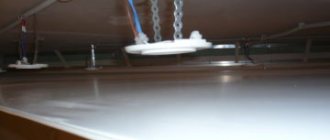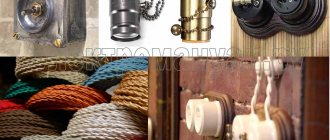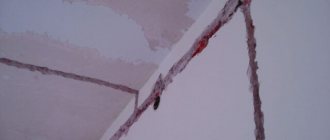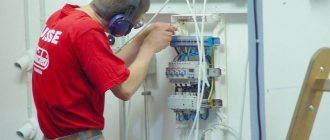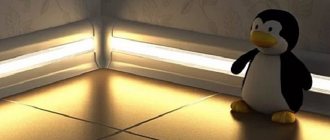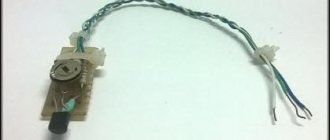When renovating a room or building a new home, preference is increasingly given to suspended ceilings. In addition to the aesthetic component, it becomes possible to organize electrical and signal wiring on a load-bearing ceiling, without gating.
Regardless of whether the wiring is organized under a suspended ceiling, panel, or plasterboard, fire safety measures and the requirements of the Electrical Installation Rules must be observed. The fact that the electrical wiring on the ceiling is not visible does not give reason to perform the work carelessly.
Important! Unlike one mounted in the wall, the cable under the ceiling is open to air access. This means that if there is a fire, the fire will spread along its entire length in a short time.
The greatest danger is the fire of electrical wiring under a suspended ceiling or under wooden floors. You will not see the moment the fire starts, and its area in a matter of seconds will be equal to the size of the ceiling.
Basic requirements for organizing wiring in the inter-ceiling space
- The laying of any cable behind a suspended ceiling is organized using fixing devices.
In wooden structures, wiring is organized on hangers, without touching the surface.
Electrical installation rules generally require cable laying in wooden houses using steel pipes.
However, in practice, corrugation made from a material that does not support combustion is usually used.
- It is advisable to lay the wire in a corrugated area. But if you use high-quality double-insulated cables (each conductor coated + outer sheath), installation of electrical wiring on the ceiling can be organized without additional “hoses”. Again, it needs to be secured and not just sitting on the drywall.
Mounting clips and clamps are used for fixation. There is a large selection of such devices on sale; it makes no sense to make fasteners yourself.
Important! Fastening wiring to the ceiling using metal fittings is unacceptable; only dielectric materials are used.
- The geometry of the installation does not matter; the wiring under the suspended ceiling can be routed even diagonally.
The ceiling suspension points should be taken into account: for this, before laying the cable, it is necessary to mark the installation locations of suspended structures. The cable is laid at a distance of no closer than 10 cm from the fastener.
- Another point that is not mandatory from the point of view of the Electrical Installation Rules, but will help prevent the formation of various interference in signal wires (television, Internet, telephone). All cable crossings are made at right angles. If possible, it is necessary to create slack at the intersection points so that there is no direct contact between the cables.
If the power and signal cables are laid in parallel, the distance between them should be at least 30–40 cm. In this case, ferrite clamps are installed at the ends of the signal cable - noise absorbers.
- Particular attention should be paid to junction boxes. Ceiling wiring (including boxes) will not be accessible for maintenance. If the cable connections are not made firmly, you have a potential source of heating and burning of the contacts. To restore functionality, you will have to dismantle the ceiling.
Next, we will consider several typical ceiling wiring diagrams for electrical cables.
Electric installation work
The profile frame is attached with self-tapping screws, which can damage the insulated part of the cable, and this in turn will lead to a short circuit. For this reason, the conductor is protected with a special corrugated pipe. It will prevent the fire of electrical wiring located under the suspended ceiling.
Corrugated wire
When installing a cable in a corrugated pipe, you may encounter problems, and you cannot do without knowing some subtleties:
- Using a ruler or tape measure, measure the amount of corrugation that will be required for installation, using a sharp utility knife. Do this carefully, as there is a wire inside the pipe that can be cut using side cutters. At the same time, you need to hold it so that it does not fall inside the corrugation. After all, if this happens, then you will have to stretch the wire by cutting the pipe to a certain length.
- Connect the end of the wire to the cable. This can be done if you carefully bend it with a hook and pierce the edge of the insulation, carefully without touching the wiring. You can wrap the wire around the cable without piercing the insulation; be sure to wrap the connection point with electrical tape so that the protrusions do not catch and interfere with the passage of the cable.
- Secure the free end. It is better to work together, so that one of the workers supports the wire, and the second one does the pulling. If there is no assistant, then the broach can be attached to a battery, a door handle, or use any object that does not move.
- To make it more convenient to pull the cable, pull the corrugation along its entire length. Do this carefully, do not overdo it with tension, so that a break does not occur at the connection point. This may cause problems.
Residential electrical repair option
A typical problem when organizing electrical wiring repairs is replacing old aluminum lines with copper ones. Repairs are not always carried out in all rooms at the same time; it makes sense to change the wiring in the apartment in stages. Ceiling wiring provides this opportunity.
As a rule, main power lines in typical apartments run at a distance of 20–30 cm from the ceiling and are located horizontally. Let's say you are installing a suspended ceiling, but wall repairs are not included in your immediate plans. You can replace the main (supply) cables in the apartment along the ceiling. In this case, it will be enough to carefully groove the walls (from the distribution box upwards) to the level of the suspended ceiling. Repairing 10–15 cm² will not be too expensive, just glue a piece of wallpaper to this place.
Let the old line remain in the wall; we simply disconnect it in the junction boxes. And we connect the new ceiling copper cable to aluminum wires using contact blocks (to prevent electrochemical corrosion). When you get to the point of renovating this room, all that remains is to replace the consumer lines (outlets) with copper ones, and all the wiring in the apartment will comply with PUE standards.
This is a forced decision in the case when repairs to the ceiling and walls are carried out over time. If repairs are carried out in the entire room at once, distribution boxes are installed under the false ceiling.
Of course, when laying main electrical wiring along the ceiling, you need to take into account the future load: you may decide to place new connection points in the room. You can install an additional junction box, run the power cable there, and reserve it.
Another modernization option (possible if you arrange suspended ceilings in all rooms and corridors) is drilling through connecting channels between rooms.
In this case, the main cable is introduced from a room with a finished suspended ceiling (of course, from a distribution box) into the room where it is planned to install a false ceiling in the future. The ends of the cable are insulated with caps, leaving a reserve for wiring into the box. Perhaps this temporary solution is not very aesthetically pleasing, but taking into account future repairs, this method is acceptable. But when organizing a suspended ceiling, you will have a ready-made input for the electrical equipment of the room.
Wiring
The routing of wires deserves special attention. It can be hidden, open, or carried out using a combined method. Regardless of the installation method, the rules and regulations for the placement of electrical wiring state:
- to minimize problems during repair work, the wires should lie strictly vertical or horizontal;
- horizontal sections should be placed at a distance of 150 mm from the ceiling (in some cases 200 mm is allowed);
- vertical sections should not be in close proximity to corners and openings of doors and windows - minimum value 100 mm;
- the distance from gas pipes is at least 0.4 meters;
- The wires themselves should not touch each other.
Organization of lighting (modernization of ceiling wiring)
Installing suspended ceilings allows you to organize room lighting in a new way. You can install spotlights instead of a chandelier, saving space in height. In this case, the supply cables must have vertical branches opposite the installation locations of the light points.
If you plan to drill holes in drywall, the wires should be temporarily lifted and then removed from the resulting holes for the light spots.
First, a plan for the placement of light sources is drawn, then their projection is marked on the load-bearing ceiling. When marking, novice craftsmen often turn the plan over to the ceiling (180°). The result is a mirror marking. Don't forget about it! The plan must lie on the floor (on the table), and the markings on the ceiling are transferred without a virtual spread.
Organization of distribution boxes when laying wiring above a suspended ceiling
As mentioned earlier, when installing a solid suspended ceiling, access to the boxes is impossible. One solution is to install boxes below the ceiling. But then the entire effect of hidden wiring is lost.
If you foresee the need for periodic intervention in the box, you can install an inspection hatch in an inconspicuous place (for example, above a tall cabinet).
There are so-called “invisible hatches” that do not spoil the appearance too much.
Then it makes sense to bring the key lines into one junction box and place it above the hatch. This will complicate installation somewhat, but will provide easy access if necessary.
And yet, the most optimal way to organize distribution nodes (at least on main lines) is to move the boxes beyond the plane of the suspended ceiling. Therefore, nodal points are made in the corridor (hallway), where mezzanines can always be arranged. All boxes will be accessible, and at the same time, hidden from view.
Video on the topic
So, you decided to install suspended ceilings and the question arose about laying the electrical wiring. For this, there are the following standards prescribed in SP 31-110-2003 (clause 14.15) and in the PUE (clause 7.1.38) . Their full description is given below. I would also like to draw your attention to the unfamiliar term “impenetrable suspended ceiling”. Briefly it translates like this. All ceilings in residential and public buildings, from the point of view of laying cables, are impenetrable, including tiled ones. But walk-through ceilings should include suspended ceilings of industrial enterprises and special structures, above which there is a space equipped with special bridges, decks, and platforms for servicing cable structures.
As a result. Two options are optimal:
1. Laying the cable in a corrugated cable (for example, VVG cable);
2. Laying cable with index ng-LS without corrugation (for example VVGng-ls)
14.15 Electrical wiring in cavities above non-passable suspended ceilings and inside prefabricated partitions is considered hidden and should be carried out:
- behind suspended ceilings and in the voids of partitions made of non-combustible materials NG and flammability group G1, electrical wiring should be carried out with wires and/or cables in non-metallic pipes and non-metallic boxes that meet fire safety requirements, as well as cables with the index ng-LS (flame retardant , with low smoke and gas emissions);
— behind suspended ceilings and in the voids of partitions made using materials of flammability group G2, electrical wiring should be carried out with wires and/or cables in metal pipes and metal boxes with a degree of protection not lower than IP4X;
— behind suspended ceilings and in the voids of partitions made using materials of flammability group G3, electrical wiring should be carried out with cables in metal pipes and metal boxes with a degree of protection not lower than IP4X;
- behind suspended ceilings and in the voids of partitions made using materials of flammability group G4, electrical wiring should be carried out with wires and/or cables in metal pipes with localization ability, as well as in metal blind boxes with localization ability;
— electrical wiring must be replaceable.
Localization ability is the ability of a steel pipe to withstand a short circuit in the electrical wiring laid in it without burning through its walls - Table 14.1.
Table 14.1 - Wall thickness of a steel pipe, ensuring its localization ability
Stretch ceiling structures can be one-piece, continuous, that is, without lighting, or with an individual lighting system, including a chandelier, lamps distributed over a PVC sheet, or LED strips. In the second case, the lighting fixtures are connected to the network in such a way that the power cables do not visually harm the aesthetics of the finish. Wiring under a suspended ceiling is one way to power the lighting system secretly.
p, blockquote 2,0,0,0,0 —>
Installation of the lighting system begins after the preparation of the ceiling surface for the installation of the PVC shell is completed. The technical execution of this type of work is not difficult, but installation of electrical wiring, like any other type of electrical work, is a responsible operation, errors in the performance of which are fraught with serious consequences.
p, blockquote 3,0,0,0,0 —>
p, blockquote 4,0,0,0,0 —>
Recommendations from a specialist
Installation is not so complicated that you can’t do it yourself. The main thing is attentiveness and accuracy. But to perform high-quality cable installation, you will need a special tool. It will be useful for installation and later for repairing devices. The set of tools depends on the professionalism of the electrician. Here is a list of those that are needed by a master working with voltages up to 1000 W.
Electrician's tool
Tools can be divided into measuring, manual and electric.
The measuring instrument includes a multimeter, thanks to which you can measure voltage, current in an electrical circuit, and resistance. Using such a tool is easy, even a beginner can do it.
A caliper is a tool that determines the cable cross-section, and this is important when working with electricity. It is needed when there is no marking on the conductor insulation.
Manual devices include the usual set for an ordinary electrician.
A set of screwdrivers, straight and curved, of different sizes. After all, the installation of electrical elements cannot be completed without such a tool.
The indicator is needed to determine the voltage on wires that are not insulated, but exposed.
Sharp mounting knife. Electrical installation work cannot be performed without a knife with spare parts.
Pliers with dielectric handles are required to remove the insulation from the wire. They are called pliers in another way; they divide the wire into two parts and twist the two parts.
Side cutters are a tool that must be of high quality and have a sharp blade. Although there are pliers that cut through the wire, you can still use side cutters to separate thicker wires and remove the insulation from the wire.
A hammer simply must be in an electrician’s suitcase. They can easily hammer a dowel into a wall surface, make a groove, or secure a bracket. Buy a tool with a rubber handle.
A chisel or chisel is useful to use together with a hammer to make a groove. They are especially suitable when work is carried out in a wooden house.
Round nose pliers are not always used for electrical installation work. But this tool can bend the wire using a curly method to make it easier to connect it to the contact.
Crimping pliers are useful if special sleeves are used to connect wires. They can be used to crimp a wire around it.
In addition to the tool, it is important to put electrical tape, a tape measure and a construction pencil or marker in the case. To work with electrical wiring, purchase a special belt with pockets where you can hang the necessary tools.
Electric tools include a hammer drill with a set of drills and crowns (for concrete or wood). Thanks to it, making a round hole is easy. And it will help you make a groove for the wire quickly.
A wall chaser is a professional assistant to a fitter. It will help you create grooves throughout your apartment without dust and in a short period of time. Its main drawback is the cost.
A screwdriver is a tool that can be used to quickly fix distribution boards to a wall surface.
Grinding machine – “grinder”. Used for making grooves for electrical wires and cutting metal.
Soldering iron - this tool is useful if you need to connect two wires together, but there is no other way.
Requirements for installing electrical wiring under a suspended ceiling
Any type of electrical installation work requires professional knowledge and skills. Experimentation, not supported by professionalism, is unacceptable when installing electrical equipment.
p, blockquote 6,0,0,0,0 —>
The work on laying wiring over a suspended ceiling begins with the design of the lighting of the PVC sheet, the development of a sketch of the layout of lamps (chandeliers, LED strips) on the surface of the decorative shell. Then, based on the design of the stretch ceiling and the purpose of the room, lighting fixtures are selected that correspond to the artistic design of the canvas and power requirements. The lighting system may consist of one or more types of devices.
p, blockquote 7,0,0,0,0 —>
p, blockquote 8,0,0,0,0 —>
Knowing the number of lamps and the power consumed by each of them, the calculation of the total load on the wiring to determine the required cross-sectional area of the cables is performed by summing the powers.
p, blockquote 9,0,0,0,0 —>
On a sheet of paper, draw up a diagram of the location and connection of lamps, installation of switches and junction boxes.
p, blockquote 10,0,0,0,0 —>
Important! If the lighting system includes LED lighting fixtures, then it must be equipped with step-down transformers.
Then, depending on the material of the base, the method of attaching lamps and wiring to it is chosen.
p, blockquote 12,0,0,0,0 —>
When doing all of the above, you should be guided by the requirements for electrical wiring, including that installed under a suspended ceiling:
- safety;
- reliability;
- maximum availability for repairs.
p, blockquote 13,0,0,0,0 —>
Rules for different types of wiring
For each type of electrical installation, you must adhere to certain rules.
The closed type is the safest, since when used, all wires are hidden and protected from mechanical stress. But it is a rather long and labor-intensive preparation procedure, namely, you need to at least prepare the “tunnels” in the wall. This method is good to use if your walls are lined with plasterboard, then to attach the wires it is enough to place the wiring behind the sheet.
Open wiring is the easiest way to lay wires. The advantage of this method is the ease of replacing or repairing the cable if damaged. In most cases, it is used in utility rooms.
The combined method of laying electrical wiring combines a closed and open laying, which simplifies the task, but nevertheless it has its own standards. Boxes for laying lines are chosen mainly from plastic; they are more practical and quite reliable. There must be free space in the box to accommodate all the wires.
Safety requirements state that if you use the open method, then sockets with switches should be located on special sockets, their diameter should be slightly larger than the size of the sockets.
It is necessary to use special flat wires APRV, APR. In the presence of flammable walls, asbestos insulation was previously used (thickness according to standards should not be less than 0.5 cm). However, today there are other safe materials with excellent insulating properties. The insulating layer is located between the wall and the wires, and in the event of a short circuit it prevents the wall from igniting.
During renovations in an apartment or house, the question usually arises of how to properly replace electrical wiring. If you want to do this yourself, then you need to know all the intricacies of proper electrical wiring installation .
As with other types of work, electrical wiring installation begins with planning, which is based on the principles of convenience and safety. Basically, of course, in developing the plan, the emphasis is on safety, because electricity is such a thing where negligence is unacceptable.
The work must be done competently and accurately, which will save you from problems and protect your home. A clear plan must be followed at all stages of work.
Features of electrical installation under a stretched PVC sheet
The wiring mounted under the vinyl ceiling lining is hidden from view, which is an undoubted advantage in terms of decorativeness. However, this factor also has a downside - the electrical wiring under the suspended ceiling after installation of the canvas becomes inaccessible for correction or routine repairs. In addition, there will be a PVC sheath in close proximity to the wires, the physical and artistic characteristics of which should not suffer from this. Therefore, the laying and connection of cables must be done efficiently, taking into account a number of rules and nuances:
- the suspended ceiling lighting system must be connected to a separate circuit breaker in the distribution board;
- for fire safety purposes, electrical wiring on the ceiling should be placed in protective covers or sleeves, which will protect it from possible flooding from above, and the vinyl film of the stretch ceiling from heating from the inside by hot wires;
- It is advisable to place distribution boxes of the lighting system in accessible places, not under the canvas;
- the pitch of the fastening clamps should prevent sagging of the wiring and its contact with the PVC sheath;
- the number of wire connections must be minimized, and the use of cables with dissimilar conductor materials must be eliminated;
- twisted wires must be replaced with soldered joints or terminal connections;
- The ceiling mounting baguette is not suitable for suspended ceilings with a lighting system, since the distance from the canvas to the ceiling surface when using it is minimal - up to 1 cm.
h2 3,0,0,0,0 —>
Installation of sockets and switches
There are important electrical wiring requirements regarding the location of switches and outlets. Switches should be placed in rooms at a height of approximately 1.5 meters from the floor, but ease of use is currently considered the main criterion.
Installation of sockets should be carried out at a height of 0.5-0.8 m from the floor level. For better placement, you need to know in advance where which equipment will be installed.
There must be at least one socket per six square meters. The kitchen must have at least three sockets, regardless of the size. In rooms with high humidity (bathroom, toilet), it is possible to install sockets that have double insulation and moisture-proof properties. Power must be supplied from a separate transformer.
It is unacceptable to install sockets in close proximity to grounded batteries or other metal objects (the distance should be at least half a meter). All connections must be in special boxes.

